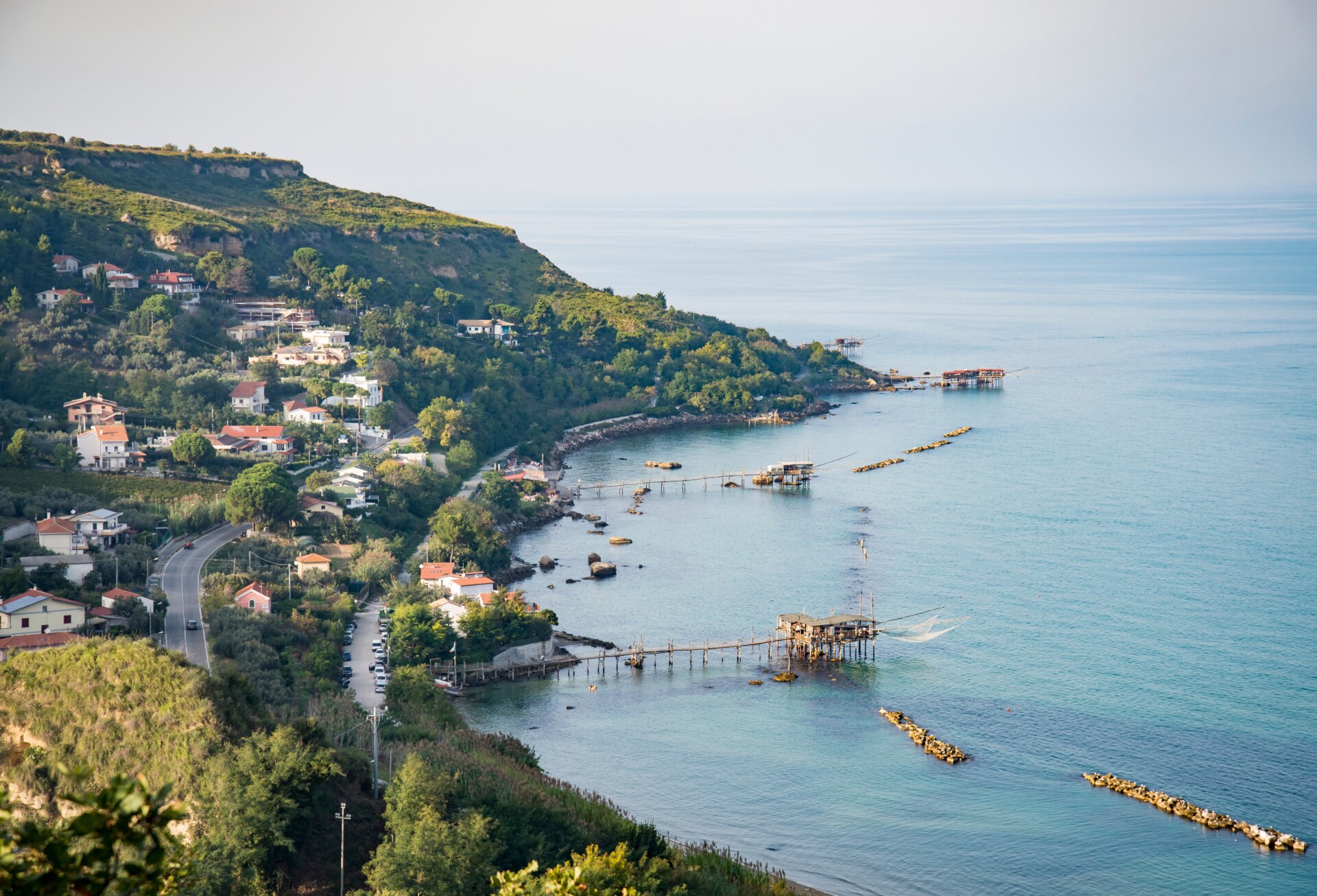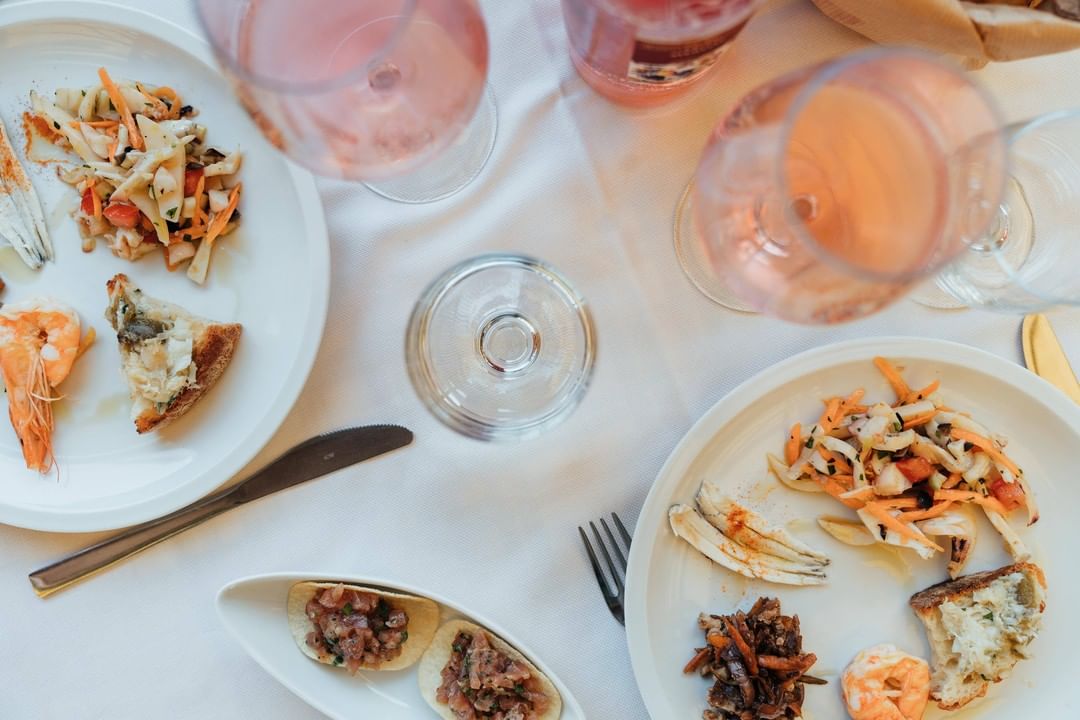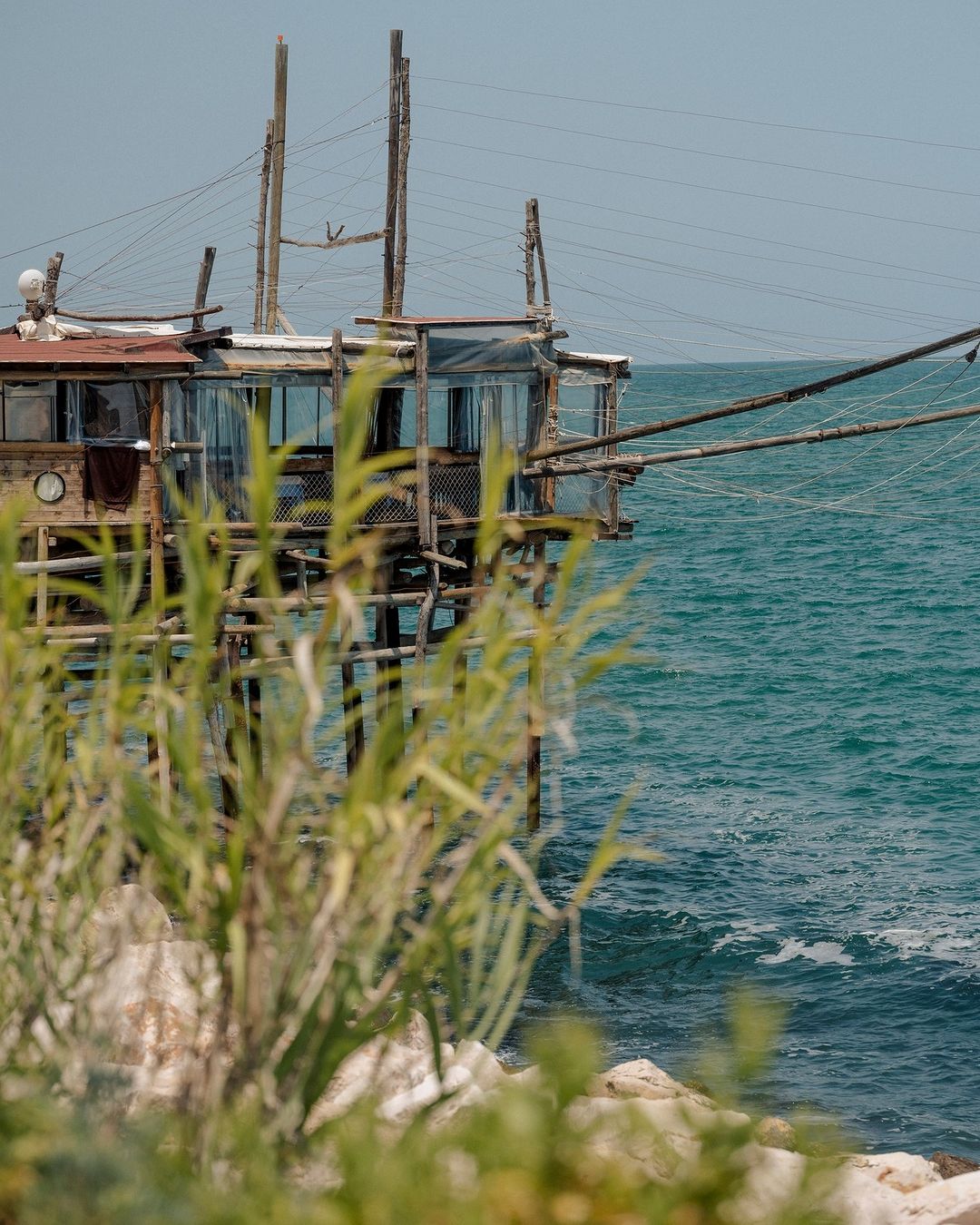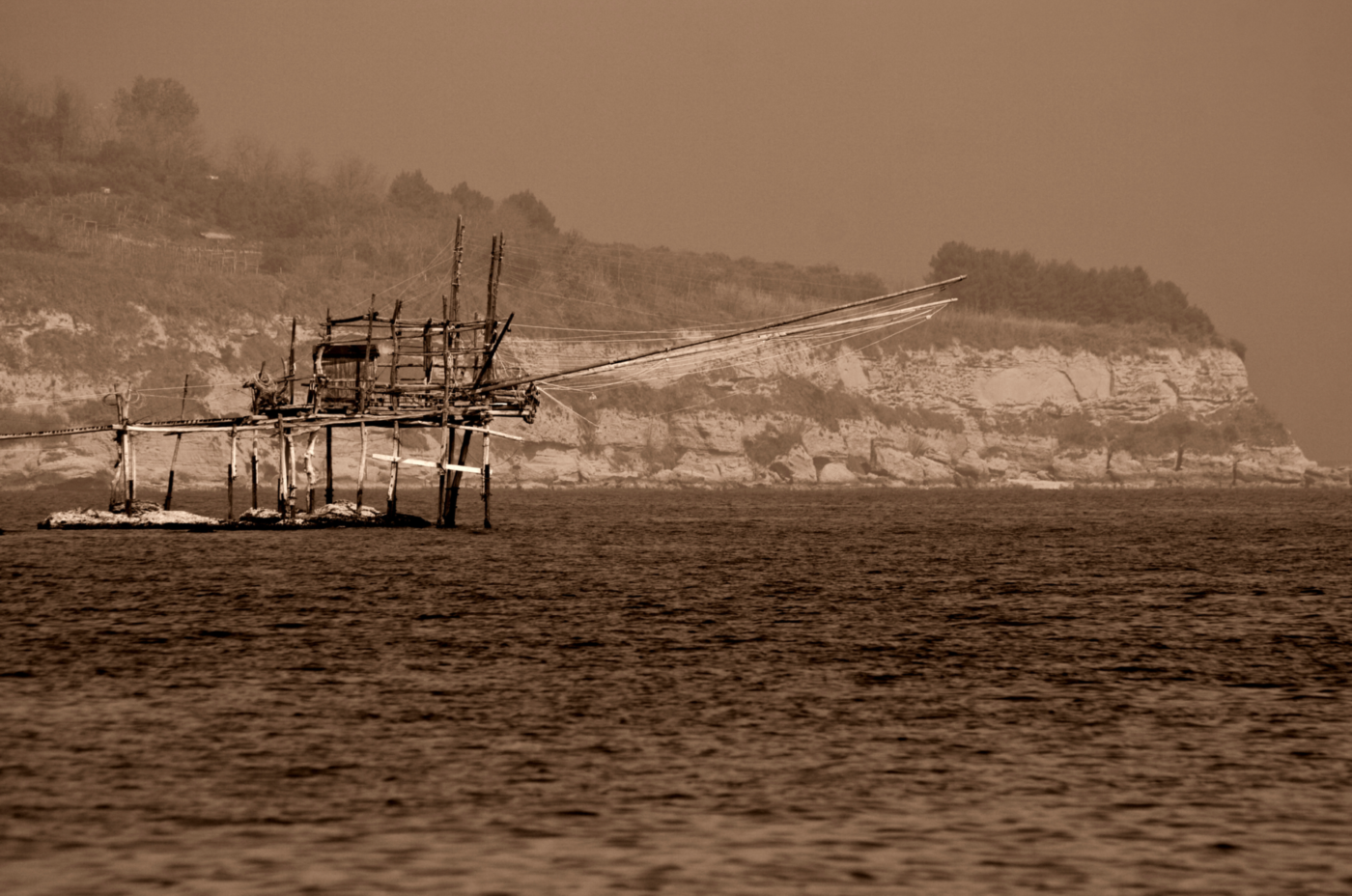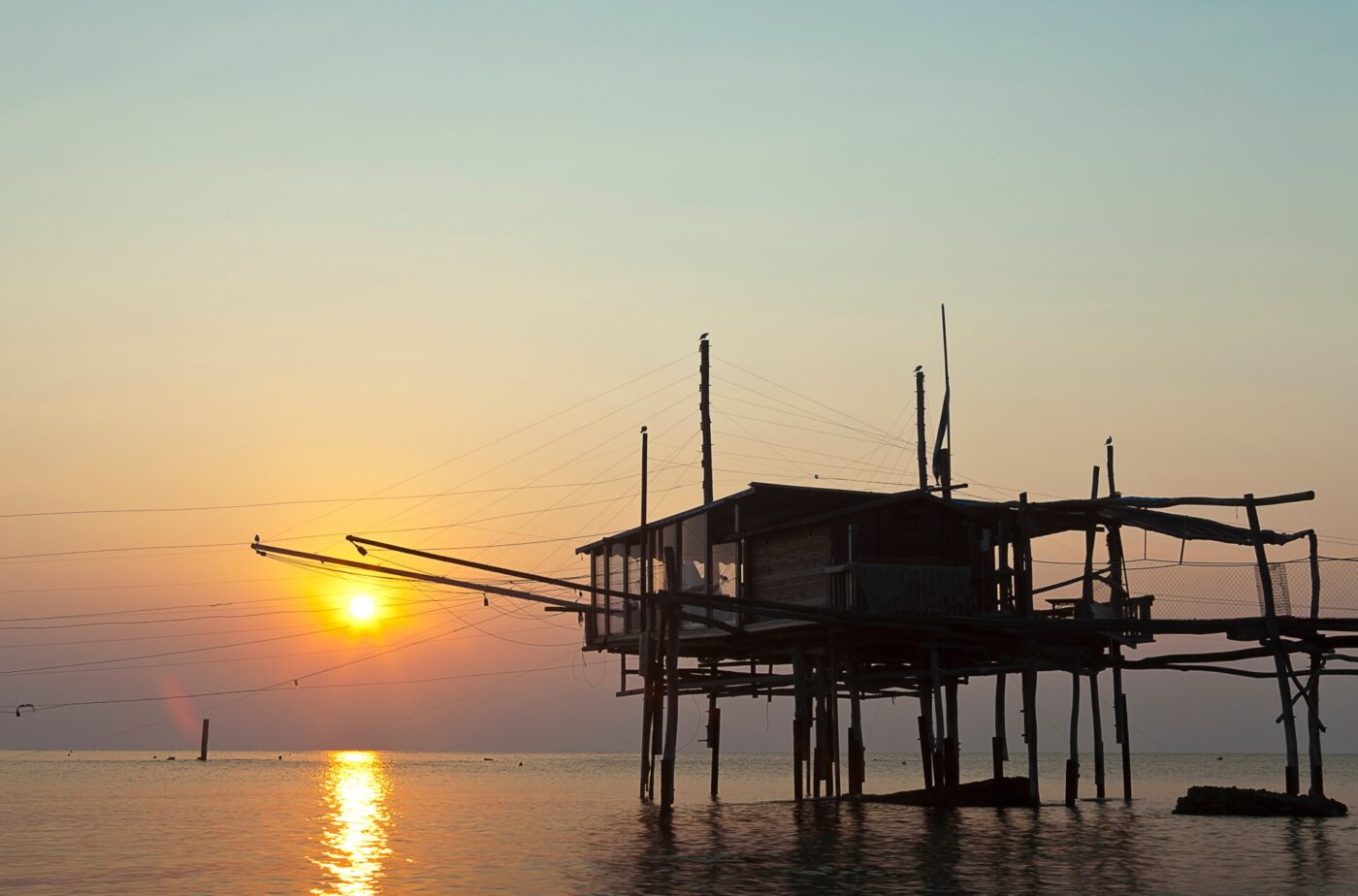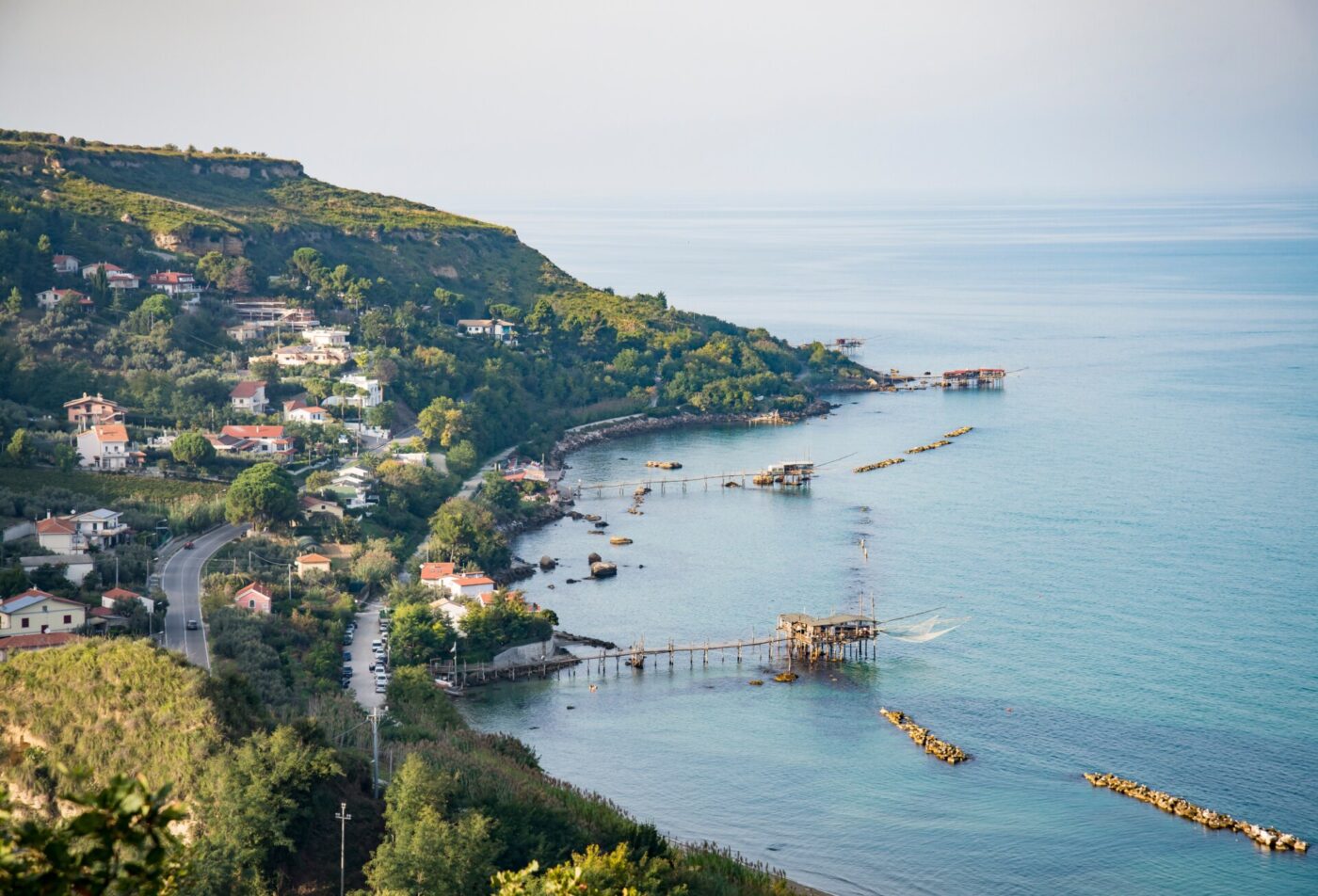On a stretch of Italy’s lesser-known Adriatic coastline, waves crash onto a peculiar and wild segment of Abruzzo known as the Trabocchi Coast, which starts in the seaside village of Ortona and runs through San Vito Chietino and Fossacesia until it reaches the marvelous Natural Reserve of Punta Aderci. But it isn’t the mighty Aragonese castle of the former nor the quiet grasslands of the latter that are most emblematic of the shoreline. Rather, it’s trabocchi that give this part of Abruzzo its name–and its character.
Tim Burton-esque and spidery, these ancient fishing machines extend over the sea, inching off the 54-kilometer stretch of coastline. Although their crude, Polynesian-stilt-house shape has remained unchanged for centuries, the trabocchi of Abruzzo have undergone various internal metamorphoses over the years to become, in their most current form, successful restaurants.
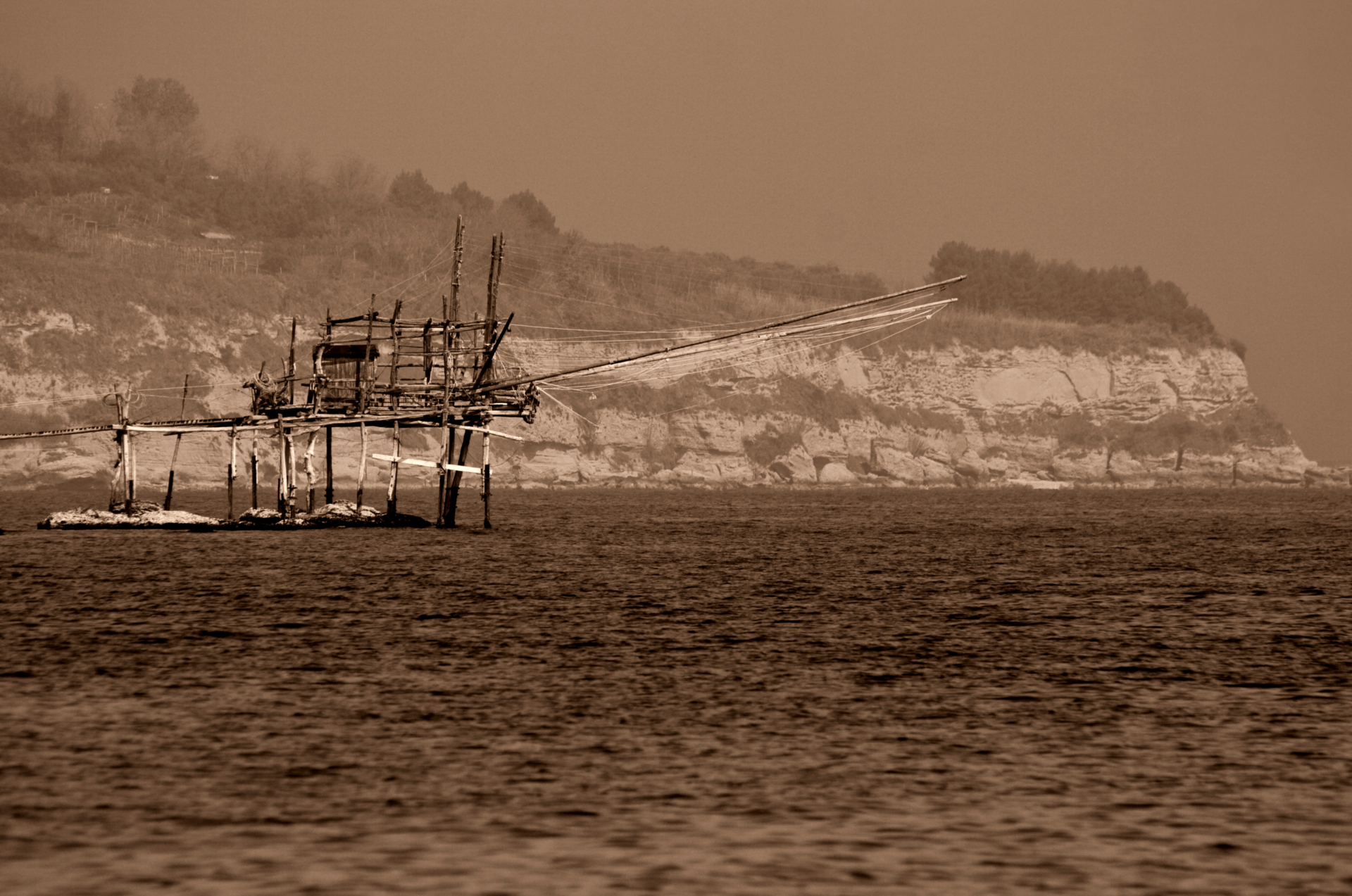
Construction at the Hands of Not-So-Seafaring Farmers
The trabocchi themselves are made of spiny acacia, an elastic and salt-resistant wood, and consist of a platform suspended over the sea, anchored to the rocky coast by a walkway of boards fastened by stakes. Wooden arms, called “antennae”, support the nets and are controlled via a winch made from a tree trunk. Although the configuration looks as if it relies on balance, and luck, the braces are carefully designed to keep the trabocco flexible enough to follow the sea currents and resist their force without collapsing.
The origins of the trabocchi are still uncertain, though the most widely accepted story proposes that the first were built between the 18th and 19th centuries, intended, contrary to what you might expect, for a purpose very different from fishing.
At the turn of the century, the Bourbon rulers launched a campaign to clear forests and till land for agriculture in central Italy. Studies suggest that the lack of long-distance roads along the Adriatic coast prompted farmers to construct these platforms to partake in the trade of the excess timber and other agricultural products that coastal cargo ships would transport to the markets of Dalmatia, the Kingdom of Naples, and the Republic of Venice. Later, the contraptions found another purpose when these same farmers wanted an alternative source of income during periods of inactivity in the fields: fishing.
These farmers became traboccanti, the trabocchi their second homes, and maintenance of and care for them essential. From up high on the trabocco, the traboccanti, by a method known as a vista, would identify schools of fish, assess marine currents, and make informed decisions about where to position nets. As such, these original traboccanti garnered a profound knowledge of local waters, fish habits, and the changing conditions of winds and tides–without time at sea required.
And this is what I love about the trabocco’s origin story; its creators were not seafarers, nor experienced fishermen, but rather land-dwelling farmers, men of the earth, who, driven by necessity, had the courage and ingenuity to reinvent themselves, finding a way to survive through fishing while avoiding the perils of the open sea… According to local lore, many of these farmers couldn’t even swim!
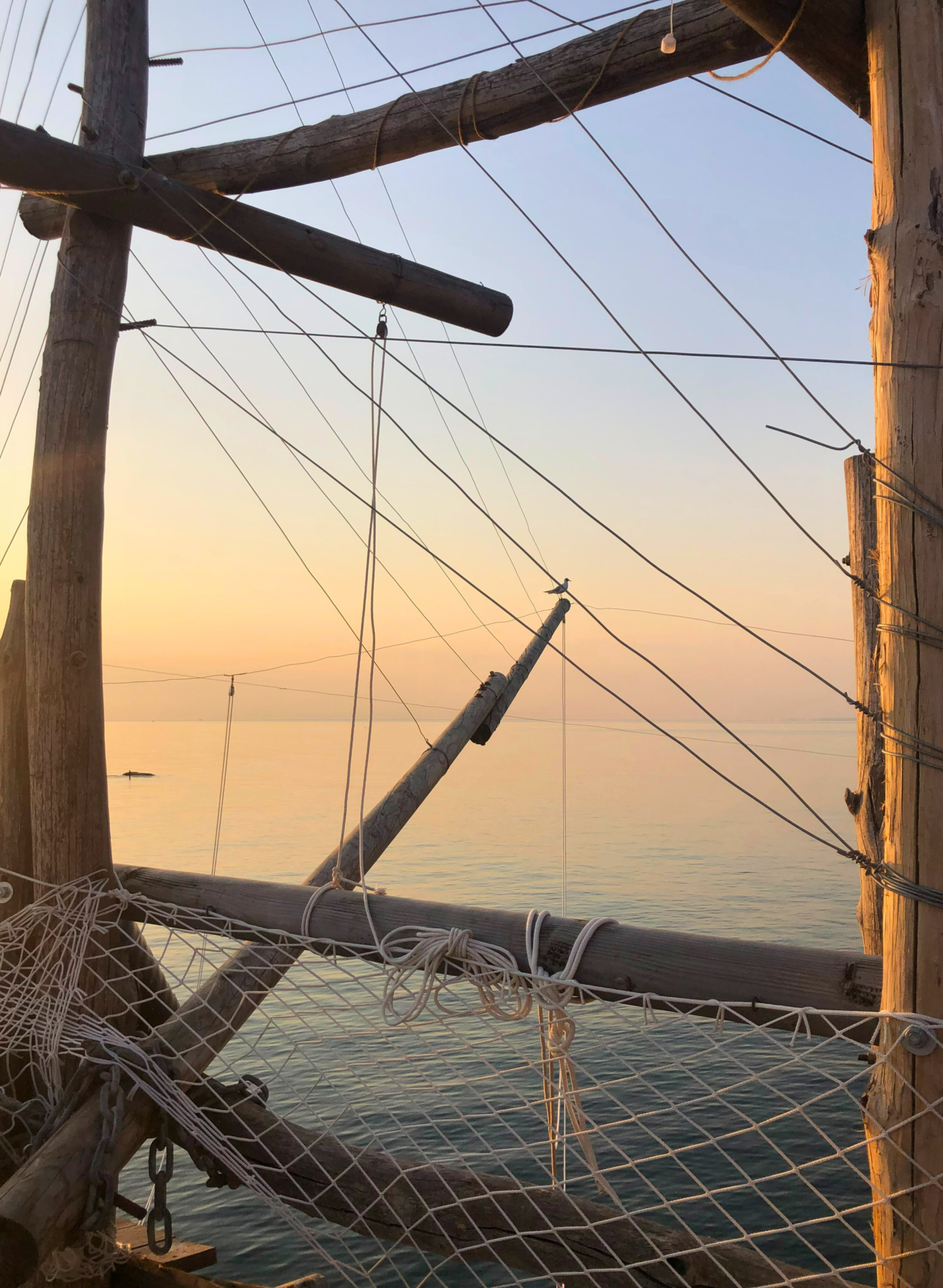
D’Annunzio and the Traboccanti of Yesterday and Today
“From the far end of the right promontory, above a group of rocks, extended a trabocco, a strange fishing machine, entirely made of boards and beams, like a colossal spider.”
–Trionfo della Morte, Gabriele D’Annunzio
In the summer of 1889, renowned poet and Abruzzo local Gabriele D’Annunzio stayed in San Vito Chietino. There, one of his most illustrious works was born: Trionfo della Morte (Triumph of Death, 1894). In the novel, he writes of the Trabocco Turchino and its first traboccante, and, thanks in part to the poet’s prose, this trabocco has become an emblem of the coast and a source of pride for the local community.
“The Trabocco Turchino is our treasure, our honor, and our responsibility,” declares Rosalinda Flamminio, the tourism commissioner of San Vito Chietino, the only municipality on the coast with a publicly-owned trabocco. “It’s a fragment of our culture and tradition. Preserving it, defending it, and narrating its history is our duty,” Flamminio continues, explaining the administration’s choice to invest in its maintenance. The Trabocco Turchino is maintained in its original form thanks in part to national funds from FAI and used for events, guided tours, and activities to educate on its history and promote local tourism. Trabocchi can also be found in Molise and in the Gargano area of Puglia (where they are called “trabucchi”), but Abruzzo is the only region with a law that regulates their use as restaurants.
Understanding the origin and history of the trabocchi is crucial, as is recognizing their evolution over time. In the past, a single trabocco could represent the sole source of livelihood for multiple families. Yet, due to profound changes in the seabed and climate variations over the years, there has been a significant decrease in the number of reef fish and, consequently, the catch obtained on a trabocco. As such, the structures are no longer economically viable, unable to support the families that previously depended entirely upon them.
The old, wooden guardians of the sea have therefore taken on a new vocation. Very few of these trabocchi-based eateries are still run by families that descend from the original traboccanti; most are managed by new owners who’ve purchased the rights to the structure or its operation. Regardless, their reemergence into the culture of Abruzzo has allowed the structures to be rediscovered by a wider audience, and the trabocco, in its modern guise, assumes a dual identity: on one hand, a tourist attraction, and, on the other, a restaurant, popular among locals and tourists alike.

Courtesy of Trabocco Punta Fornace
“I believed in this idea from the beginning,” proudly states Gabriele Nardone, owner of the Trabocco Punta Fornace restaurant, famous for its delicious scialatielli allo scoglio (seafood spaghetti) and frittura di paranza (fried small fish). “Despite the challenges of managing a restaurant on a trabocco, exposed to the elements and changing weather conditions, as well as to bureaucracy that is not always clearly defined, it’s worth it every day,” he tells me. “I am gratified by the curiosity of tourists; after tasting our local dishes, they often ask to learn about the history of the trabocchi, our coast, and our land.” Satisfaction here comes two-fold: Nardone offers a one-of-a-kind dining experience while also contributing to the preservation of Abruzzo’s history and cultural heritage, for the trabocco closes its restaurant doors and reopens as a fishing machine during the winter.
Although most of the trabocchi along the coast have been transformed into culinary hot spots, you can still find a few privately-owned structures, as well as the aforementioned publicly-owned Trabocco Turchino.
Forty-one-year-old Mario Altobelli–official keeper and maintainer of the Trabocco Turchino since 2017–nostalgically recounts, “I grew up watching the traboccanti at work. I remember my mother calling us on Sunday mornings to join her on the trabocco, where she had prepared lunch with friends and relatives, while we children threw tantrums because we wanted to stay and play on the beach… And to think that now, unbelievably, we pay to dine on a trabocco!”
Mario speaks passionately of what his partner jokingly refers to as his “lover”: the trabocco that has been under his care for six years. “Everything I know, I learned through experience. There are no manuals, so it’s essential to continue talking about the trabocchi, spreading its history, and teaching others how to care for it. The old generation of traboccanti is slowly disappearing, even among people my age,” Mario shares. He says that as soon as his son is old enough, he will pass on the art of the trabocco, in what he believes is a crucial step to preserve the trabocchi’s identity.
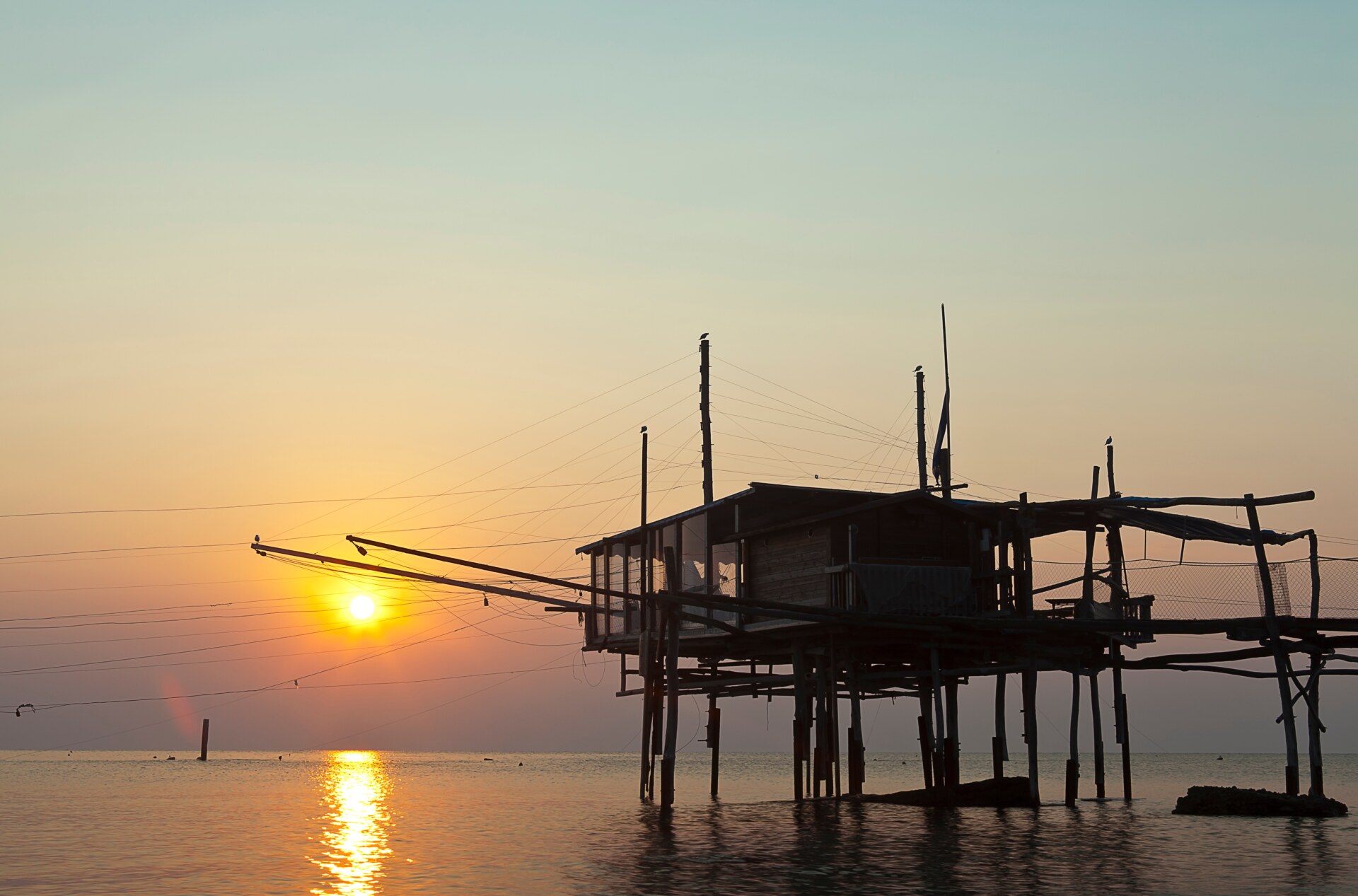
Trabocco Punta Rocciosa
The Coastline: Not Only Trabocchi
For those looking to explore the Trabocchi Coast further, between picturesque cliffs and golden beaches, don’t miss the “Via Verde.” This bike path, built along a former railway track by the sea, offers breathtaking views of the sea and trabocchi along a route of about 42 kilometers; in 2023, the section from Ortona to Fossacesia was chosen for the start of the Giro d’Italia.
Beyond the rich history of the traboccanti and their sea, anyone arriving here will find a land that has long deserved a slice of the spotlight, one that holds secrets, legends, and traditions echoing through the narrow alleys of fishing villages and sunny beaches. There is delicious seafood and local wines, ancient olive trees, and the Abruzzese people–genuine, welcoming, strong, and kind.
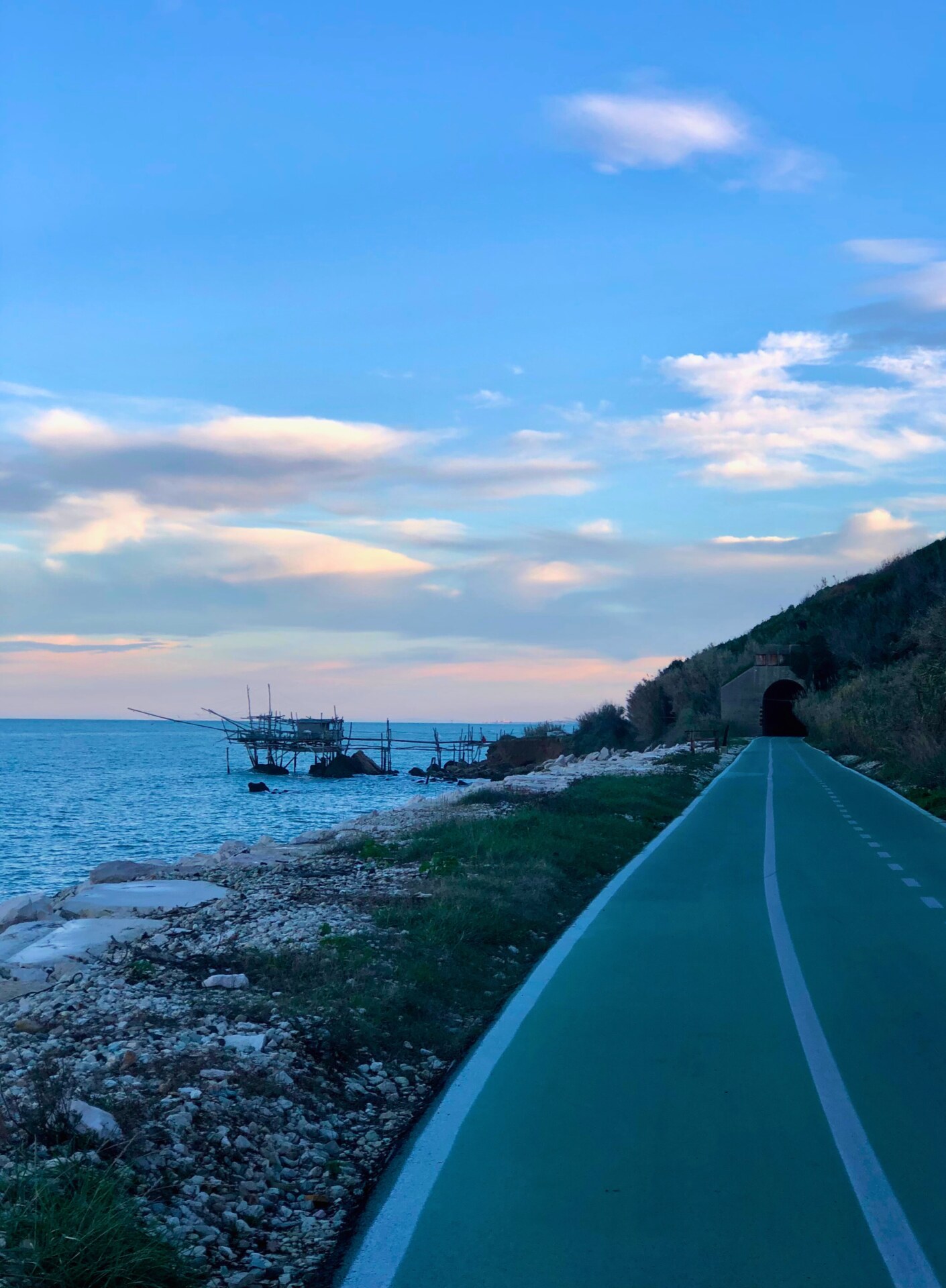
Via Verde
